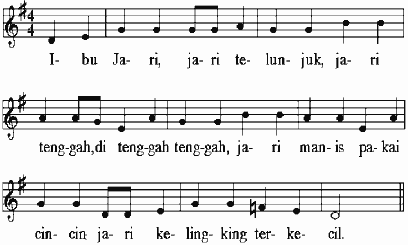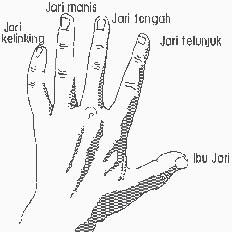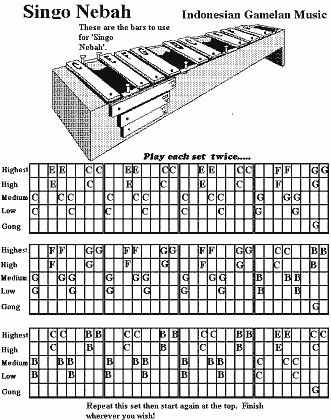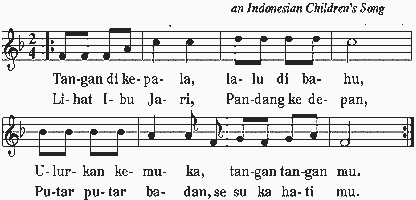 |
 |
Music in Indonesian Settings I
A Brief Description of the Unit
What the study is
focussed on, for whom it is intended and the level of commitment
expected:
During this unit of work students will be introduced to selected
Indonesian music which they will have the opportunity to study through
performance and listening analysis, to compare and contrast with other
indigenous art works and to present as re-creations for audiences
within their own classes and schools. There may also be
opportunities for students to create their own performance items
drawing on ideas, concepts and their own imaginations as a consequence
of studying music and dance in this way. It is important that all
students be encouraged to participate.
Rationale
Why the unit is being
conducted
The unit should encourage students in Australian classrooms, through
increased awareness of Indonesian music, its construction, its
historical and other cultural contexts and its performance, to be
sensitively aware of worldviews other than their own and of accepting
these as being as valid as their own. It is easy to be driven in our
teaching by the desire for our students to understand musical concepts
which are west-centric high arts constructs, such as music theory,
analysis and literacy which may bear no relationship to the music of
any other culture but their own(Bridges,1984). Where it does
happen the music of other cultures and even popular music may be
included only as vehicles for teaching mainstream concepts, based on
the west-centric 'elements of music - melody, rhythm, harmony timbre,
and form,' - approach (Smith,1993). This unit attempts, by
focussing less concern on musical literacy or the 'elements' of music,
to let the art and music speak for themselves.
Anticipated Learning Outcomes
The aims of the study
are....
As a consequence of their participation in this unit of study students
should have, through observing, learning, rehearsing, performing and
presenting examples of Indonesian music,
- experienced Indonesian music and dance, from traditional to contemporary;
- an increasing awareness of the way Indonesian people view the world;
- had opportunities to compare and discuss music with which they are familiar and other musics particularly but not exclusively Indonesian music;
- been provided with opportunities to reflect on tolerance and inclusivity;
- an appreciation of the strengths of Indonesian culture and what they and other Australians can learn from studying it;
Work Requirements
What work students must complete to match the
anticipated learning outcomes:
Students will take part in the activities detailed throughout the
teaching and learning sequence, all of which are designed to support
the anticipated learning outcomes. These are detailed where
appropriate at each stage of the process in this program.
Resources
- A tape of samples of music to be experienced during the study.
- Music, and related Arts and Crafts, Drama and Dance items.
- Newsprint (butcher's paper), felt tipped marking pens (textas).
- Related arts and interdisciplinary work (Search the web).
- For original work: Butcher's paper, textas, instruments and other sound makers, separate working spaces if possible.
Moving towards an Indonesian environment
Obviously there are a number of things we can not do to
preserve our Indonesian Song's authenticity. Our children have
not arrived at school from Indonesian homes...at least most
haven't. Our schools do not operate in 'shifts' as do many
Indonesian schools. Very few of our students are able to speak
Indonesian. The food we eat at recess and lunchtime will probably
not be Indonesian. And so on and so on... But we can go
part way to creating an Indonesian environment in our classrooms, so
that our song has some appropriateness. Anything is, I believe, better
than nothing...the more we are able to do the better.
As far as it is possible we can use Indonesian words and phrases in our
music lesson. These might include salutory greetings...'selamat
pagi' if it is morning, 'selamat siang', late morning, 'selamat sore',
afternoon, 'selamat malam', good night and so on. If you would
like to be even more ambitious consider greeting the students as 'anak
anak' (children), ie 'selamat pagi, anak anak.' They can greet
you as (if you are female) 'Ibu ...........' or (if you are male) 'Pak
.............'(short for 'Bapak')
'Diam' is a useful word even if its use goes contrary to my suggestion
that verbal reprimands are rather a waste of time. It means
'...be quiet'. 'Harap diam' is a more polite way of expressing the
same, 'I would like you to be quiet.' Of course good
manners go a long way...'Terima kasi' is 'Thank you'!
If you are still being adventurous at the end of your lesson, farewell
your departing students with 'Selamat jalan, anak anak,' (a
farewell for those leaving) to which they should reply 'Selamat
tinggal, Ibu/Pak ..........' ('ngg' is like ng in sing but with
an extra hard 'g'...like people from Birminggham say it!!) Be
brave...if its's good enough for us to expect the students in our
classes to learn new concepts why should we escape! I learnt the
Indonesian words for colours (as I use them in this lesson) within the
short space of one lesson with a class of year 3 students who got a lot
of fun out of my many mistakes...but we all got there in the end, and I
gained rather than lost kudos by making my mistakes so public!
Other useful classroom phrases include 'Sudah siap?' ('Are you ready?')
to which the hoped-for reply is 'Ya, sudah!' ('Yes, ready!')...
('belum'= 'not ready'), and one of my favourites...'Tangan di kapala!'
('Hands on head!') which I use frequently in music classes as an
effective control.
1. Enjoy the 'first time' experience of discovering a performing arts event
Description of the methods
 Mrs Boldwill invites her Years 6
and 7
students to listen to and enjoy the 'first time experience of
Indonesian music which she has recorded as a medley of musical
excerpts. These range from traditional gamelan to folk songs and
from contemporary serious through 'commercial' music genres. She
directs the students to listen, at this time, without making any
comments or giving any feedback. She says they are simply
encouraged to enjoy the 'first time 'experience. However Mrs
Boldwill does place her expectation on her students that they will
demonstrate their ability to listen to the musical excerpts without
distraction, and with awareness. She suggests to them that this
might be an aspect of her assessment of their
Mrs Boldwill invites her Years 6
and 7
students to listen to and enjoy the 'first time experience of
Indonesian music which she has recorded as a medley of musical
excerpts. These range from traditional gamelan to folk songs and
from contemporary serious through 'commercial' music genres. She
directs the students to listen, at this time, without making any
comments or giving any feedback. She says they are simply
encouraged to enjoy the 'first time 'experience. However Mrs
Boldwill does place her expectation on her students that they will
demonstrate their ability to listen to the musical excerpts without
distraction, and with awareness. She suggests to them that this
might be an aspect of her assessment of their participation in this lesson.
participation in this lesson.
Next the class performs new music which is similar. Mrs Boldwill
introduces the songs, 'Tangan di Kepala' and 'Ibu Jari' from a
recording she has found with both on it.
Actions for 'Tangan di Kepala'
Hands on heads, then on shoulders, out in front, shake
your hands about.
Look at Mrs Thumb, Keep looking.Turn your body around, Hand on your
heart.
Assessment points and indicators
Mrs Boldwill's students have begun to explore ideas and
feelings through music. Although, at this time, their responses
are informal and unrecorded Mrs Boldwill's students should be beginning
to react to key features of the music played them and the two new songs.
2. Return to the 'first time' event - discuss opinions and feelings
Description of the methods
Mrs Boldwill asks her class to sit quietly at their
desks. When they are settled she explains that she is going to
play the tape she asked them to listen to without comment the previous
week. However this week while she would like them again to enjoy
the experience of listening to unfamiliar music they are going to have
the opportunity to comment on what they heard and how they reacted to
it. She plays the tape from the first lesson again. When it
concludes she says nothing for a few seconds, signalling casually to
her students that she wants them to just sit quietly for that
time. Now she encourage her class to talk about what they heard,
and to discuss their opinions and the feelings the music evoked for
them. As a few open the discussion with their reactions others
begin to feel 'safe' with numbers and a regular flood tide of opinions
flows over the room. Some comment on the music, others comment
and respond to their comments.
Now Mrs Boldwill invites them to nominate more songs which they think
are similar to some of these and, where possible, to perform those
together informally. One student thinks a song sounds like the
South African 'Wimoweh'. Others agree.
'Let's sing that then,' suggests Mrs Boldwill and the class joins her
in singing it.
Mrs Boldwill revises the two Indonesian action songs 'Tangan di Kepala'
and 'Ibu Jari' with the class who, while they initially thought the two
songs were a bit 'juvenile', now enjoy performing them.
Next they share reading of J Brandt Buys poem 'The Gamelan Gilds the
Time' and notes about the gamelan. The lesson concludes with
discussion about the poem and their research about Javanese Gamelan.
Javanese Gamelan.
The Gamelan gilds the time.
The hours forget their
usual course.
The quarters shrink to golden minutes, minutes seem like blissful hours.
Now in the softer moments, the music sounds as if I heard angels sing,
Now, when at half strength, as if I heard all the chimes in heaven.
And then again, in the fullness of its mighty power,
It is as if a storm of bronze thunders through my temples.
J.S.Brandts Buys.
From their reading and 'web-surfing' the class finds
that Gamelan
derives from two words, 'gamel' 'to handle' and 'gangsa', the word for
bronze. The word embraces a variety of musical ensembles in
Western Indonesia. All have tuned metal gongs, gong-chimes,
metallophones and drums, and frequently include a xylophone, flute,
2-stringed fiddle(Rebab) and singers. While most gamelan gongs are made
of bronze, iron and bamboo are sometimes used. Gamelan have a lengthy
history, as carvings at Borobudur and Javanese mythology
indicate. Some gamelan are sacred, and only played at religious
ceremonies.
The forging of the metallic instruments is shrouded in deliberately
promoted mystery, handed down among the 'smiths' across countless
generations. The three parts tin to ten parts copper is believed
capable of creating a living sound making the Gamelan a living spirit.
No two Gamelans are exactly tuned, giving Gamelan orchestras 'a
shimmering sound'. Gamelan must be played regularly to maintain their
'life'. Like humans it takes twenty years of playing for them to reach
'maturity'.
Assessment points and indicators
Mrs Boldwill's students respond to key features of
music and related art works under study, giving their own reasons for
their likes and dislikes. Students respond to key features of art
works. She has them talk and write informally about their
personal observations.
3. Re-create the 'first time' event
Description of the methods
While the remainder of the class is at a Physical
Education (PE) lesson with the school's PE specialist Mrs Boldwill has
two students excused from physical activity help her to arrange sixteen
tuned percussion in four rows of four across the room. They set
these up smallest to the front, largest to the back.
When the class returns from PE she seats her students
on the floor with two behind each instrument. Then on the clean
whiteboard at the front of the room Mrs Boldwill carefully sets up a
'block' of 16 squares in sequence. Into these she enters 'dashes'
and letters as follows:
She tells the class that these notes in the second line of the first
set they will play 'generate' the rest of the music, just as does
each second line of the other two sets they are about to learn.
She explains what she means:
'This line will be the line people in the SECOND row play. To find out what the fourth row will play we have a simple rule - choose the last letter in each group of four beats and put it in the first and third squares, like this:'
Now she invites rows one and two to play the second line and rows three and four to play this new line at the same time. They practise this together several times, the back two rows playing one the 'first' and 'third' beats and rows one and two following on beats 'two' and 'four'.
Now she copies on to the board, in the same way, the
'generator' for the second set of the music.
Using the previous model they work out, together, that the third and
fourth rows will play
They add these to the lines already learned and play through both
twice. One line remains. She has the class play each
twice through to the bottom of the page.
Now she asks them to look again at the music she has
charted so far. Can they find patterns? Can they use these
patterns to help them work out how the last set of lines will go?
After some hazarded guesses some students realise that the last four
beats of a set herald the next twelve of a new set.
'So how will the last set go, if you know that the music goes around in
circles and we go back to the beginning from the end?'
Finally this is what they come up with:
Now they have all three sets for rows two and four. Mrs Boldwill tells row one that all they need to do is play the same as row two but play two notes for every one. She also directs row three to use row four's notes but in a different rhythm pattern. Instead of row four's first and third 'crotchet' (or 'quarter note') pattern they should play to this rhythm:
They play around with this notion just working on the first set. It takes time for everyone to understand but Mrs Boldwill believes firmly that the best way to learn is to 'do' and she has them play over their own lines together with the others until it begins not only to make sense but to sound very effective both rhythmically and harmonically.
The concept is difficult but ultimately quite
logical. Mrs Bothwill believes too that by understanding how this
piece of music works her students may begin to have an understanding of
how time goes around recursively in the animo-Hindu worldview of old
Java. Now they have the whole piece charted on the board, some of it
written up without their input, but the remainder calculated by the
class using some simple but very effective musical rules.
Mrs Boldwill says one thing is missing. 'We haven't put in the
traditional opening, called the buka.' She charts this on the
board and selects a solo student to play the 'buka' or introduction

She explains to her students about the reasons the music works like it
does: 'Because this music grows from the Hinduism which was
traditional in parts of western Indonesia it is 'circular' rather than
linear in the way it passes through time. Really it has no true
beginning or end. You may finish when you feel the time is right!'
Later the class views a video of a Javanese gamelan orchestra.
Briefly they brainstorm this 'first-time' experience of a traditional
Javanese lancaran, discussing ideas, opinions and other feelings they
have about the music and the dance.
Mrs Boldwill uses 'who, what, how, why, when, where, which' questions
to help elicit appropriate answers. These include 'What did we
hear?' 'Who performs the music ?' 'Why do you think this music came
into being?' 'How do you feel about it?' 'Why?'
They talk about the instruments they saw and match them with pictures
and descriptions in a book which describes instruments of the gamelan
orchestra. They notice that there are instruments like xylophones
or marimbas, These have metal bars or keys suspended over a wooden
base. Some have resonators (sound boxes), others don't.
Struck with wooden mallets these instruments, starting with the Saron,
the Demung which is an octave lower and the Saron Paneris or Peking, an
octave higher, play the main tune.
Then there are knobbed gongs including the bonangs, the kenongs which
are larger, and the ketuk which are smaller.
Then come the suspended Gongs which are the largest instruments of the
gamelan orchestra. They hang vertically, and mark the main events of
the music.
The smallest gongs kempul, plays the highest pitches. The largest
gong ageng opens and closes each section. Its deep note is so low that
often we can only just hear it.
Other instruments may also be played in the gamelan orchestra. In
fact a pair of double headed hand drums 'leads' the Gamelan, setting
the timing and speed. Sometimes a two stringed spike fiddle the rebab
performs, playing the buka for vocal pieces and a bamboo flute, the
Suling or a type of zither may also join in. And, of
course, another instrument is highly valued, the human voice.
Solo singers and choirs often join the gamelan to perform.
Assessment points and indicators
Mrs Boldwill notes, anecdotally in her record book
comments based on these questions:
- How well did students engage with the topic?
- Did they join in discussion?
- Did they attempt and how well did they follow through tasks set them?
- Were they able to identify the cyclical nature of the music?
- Were any able to anticipate how the music would change and could they explain why?
- Did students offer comments or preferences in critical appraisal of the work?
- Were they critical of their own performance?
